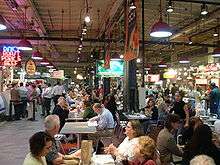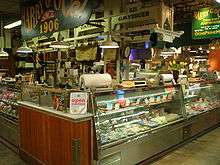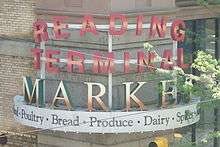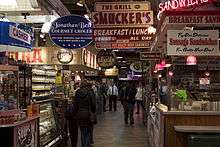Reading Terminal Market


Reading Terminal Market is an enclosed public market found at 12th and Arch Streets in downtown Philadelphia, Pennsylvania. Over one hundred merchants[1] offer fresh produce, meats, fish, artisan cheese, groceries, ice cream, flowers, grilled cheese, baked goods, crafts, books, clothing, and specialty and ethnic foods. Every space in the market is rented out; three of the vendors are descendants of original market merchants. The market is open every day of the week (regular hours: M-Sat: 8am-6pm; Sun: 9am-5pm). The Pennsylvania Dutch merchants (a small but significant minority) generally do not operate Sunday through Tuesday.
Structure
The Reading Terminal Market occupies the ground floor and basement levels of the Reading Terminal's former train shed, now part of the Philadelphia Convention Center. Market stalls occupy the ground floor with entrances on Filbert Street to the south, Twelfth Street to the West, and Arch Street to the North. The stalls are arranged in a grid pattern with an open area in the center with tables and seating. It is full of many different kinds of ceiling fans.
The Market was one of the first to feature a state-of-the-art refrigerated storage area in the basement. The basement storage area consists of 52 separate rooms ranging in volume from 5,000 to 17,000 cubic feet (141.5 to 481.2 m³) for a total of a half-million cubic feet (14.000+ m³) of storage space (O'Neil, p. 13). The temperature of each room can be controlled individually to meet temperature requirements for different goods: 15 to 25 °F (−9.4 to −3.9 °C) for meat and poultry, 34 °F (1.1 °C) for fruits and vegetables. The refrigeration system uses brine water and ammonia and includes an array of specially designed pumps, compressors, and other equipment in its operation.
History
Origins

Open-air markets flourished in Philadelphia since its founding. Growth of the city demanded more markets, and the string of open-air markets extending from the Delaware River ran for six blocks, or one full mile, prompting the main street (then called 'High Street') to be renamed 'Market Street.' Soon after the markets reached their peak growth and capacity, open-air markets within the city became seen as dirty and unhygienic by the public. The frenzy of activity along the main street was seen as a nuisance and traffic hazard. In 1859, city officials bowed to public pressure and dismantled all of them. This prompted two indoor markets to open at 12th and Market Streets, Franklin Market and Farmers' Market. These two would be the foundation of the Reading Terminal Market.
Expansion and growth

The Industrial Revolution brought with it the expansion of the railroad, and great palatial urban terminals sprang up in major cities. The Reading Railroad's headhouse terminal was designed by architect F. H. Kimbal of the Wilson Brothers Architecture & Engineering firm in 1891, and opened in 1893. The rails were elevated to reach the train shed platform built over top of the new consolidated market, which opened a year earlier. George McKay was chosen to be the Market's first superintendent while the building was undergoing its final phase of construction.
The state-of-the-art refrigerated storage area in the basement opened for use in July 1893. The storage area was more expensive to maintain and had a larger staff than the market itself. Refrigerating the basement storage area was thought to be well worth the high cost. It allowed merchants to keep seasonal products on stock all year round for the first time. The storage area was also leased out to third parties for storing other goods. Restaurants and plant and produce sellers around the area leased out space in the basement. Hospitals used the basement area to store perishable medicine. Local Breweries, including Yuengling (O'Neil 2004, p. 14), used it to store their hops.
In its first few decades, the Reading Terminal Market was a success. There were 380 merchants in the first year of operations, and the market had nearly full occupancy for the following 60 years. Business, already good, flourished with the innovation of a free market basket service, which allowed suburban housewives to get grocery orders delivered to and held at their nearest train station.[2] Refrigerated trucks allowed the market to reach into some 60 suburban towns as well as seaside resorts along the New Jersey shore.
Decline and rebirth

The Great Depression of the 1930s brought hardship to the Market. By the late 1930s, merchants were under increasing pressure from the AFL and CIO to join their respective labor unions. This led to a series of strikes that further disrupted business. The introduction and proliferation of supermarkets also hurt Market Business during the 1930s. One of these new establishments opened across on the other side of 12th street, directly competing with the Reading Market. Pressure to compete with supermarkets led to fewer stalls being run by farmers, and more being run by middle men reselling a variety of goods (O'Neil 2004, p. 19).
Despite the turmoil brought on by the depression and new competition, the Reading Terminal Market remained afloat during the 1930s. By some accounts, the Market did rather well. According to George H. Eltien, then superintendent, the Market was shipping phone orders to 38 states, Canada, and Mexico throughout the decade (O'Neil 2004, p. 18). Pressure from supermarkets was not hurting all of the merchants. Ten of the market's 64 merchants had been there since its founding in 1892. In 1930, the Reading Terminal Market Merchants Association was formed in an effort to promote and advertise the market and avoid losing business. The Association was responsible for several promotional events including the first annual Food Show and Home Progress Exhibitions. It also helped to fund a 1934 renovation of the Market's facade that installed new electric lights and window decorations.
America's involvement in World War II during the 1940s affected the Market primarily in a positive way. In 1944, the most economically straining year of the war, the Market was at 97 percent occupancy. Food shortages brought on by the war increased the demand for the Market's goods. On May 9, 1946, the Reading Terminal Market experienced its largest recorded crowd (O'Neil 2004, p. 19). Over 12,000 people gathered at the market to purchase meat, poultry, and pork products that were unavailable elsewhere due to shortages.

The suburbanization of America and decline of the railroads in the 1950s and 1960s severely affected the market. The market began running on a deficit in 1954, and by 1959 was only 70 percent occupied, forcing Reading to raise rents (O'Neil 2004, p. 20). The state-of-the-art cold storage facility was shut down and dismantled, forcing tenants to supply their own. Several other events hurt the Market and its merchants financially. The Dock Street wholesale market was closed and demolished as part of the urban renewal program in Society Hill. This hurt many resellers at the Reading Market who depended on the Dock Street market for supplies (O'Neil 2004, p. 21). On January 16, 1960, a four alarm fire broke out in the Reading Terminal's powerhouse, causing power outages that led to lost business and spoiled food.
The railroad company filed for bankruptcy in 1971, and ceased to function as a railroad company in 1976. The company continued to serve mainly as a real estate business, but paid little attention to the managing and promoting of the market, and pondered ways to get rid of the market so that it would be easier to sell the terminal building (O'Neil 2004, p. 27).

In the 1980s the Reading Company changed its attitude towards the market and began efforts to revitalize it. Those efforts continued after SEPTA Regional Rail trains moved from the train terminal above the market to the new underground Market East Station (now Jefferson Station) below it in 1984. In 1990, ownership of the Reading Terminal and the Market passed to the Pennsylvania Convention Center Authority (PCCA), and in 1994, Philadelphia City Council established a new, non-profit Reading Terminal Market Corporation to operate the market. The Reading Terminal Market Corporation and the PCCA continued the revitalization program begun by the Reading Company, recruiting new tenants and increasing promotion of the market. By the mid-1990s to the 2000s, the market was once again living up to its founders' vision. Over 90% of its leasable space is occupied by profitable and stable vendors. (ABC News, October 28, 2005) Since October 2006, the Market has been open on Sundays as part of a "trial" program that has been extended twice. (Hefler, October 16, 2006) The market is currently open 7 days a week, but not all vendors are open on Sundays. The Pennsylvania Dutch vendors are open Wednesday through Saturday.
The market's place in Philadelphia

Today the market serves as a popular source for singular culinary treats and unique merchandise, and is listed with such Philadelphia tourist destinations as Independence Hall and the Liberty Bell. It is adjacent to two Marriott Hotels, a Hilton Garden Inn, the Pennsylvania Convention Center, SEPTA's Jefferson Station, the Philadelphia Greyhound Terminal, and another Philadelphia landmark, The Gallery at Market East mall. (gophila.com, 1998–2007)
Philbert the pig, a sculpture by Eric Berg, is the Market's mascot and donations made to this 'piggy bank' go to support healthy eating programs at The Food Trust (gophila.com, 1998–2007)
The market was a filming location for several major motion pictures including Trading Places and National Treasure. One of the market's stands, Tommy DiNic's Beef and Pork, was featured on Travel Channel shows Man v. Food and Adam Richman's Best Sandwich in America. Other notable stands include Melktraft Grilled Cheese by Valley Shepherd Creamery,[3] Flying Monkey Bakery, Franks A-Lot, Beck's Cajun Cafe, The Original Turkey & Bassetts Ice Cream [4]
See also
References
- ↑ List of merchants
- ↑ About Reading Terminal Market – "DID YOU KNOW? Customers once were able to get their orders delivered by passenger train"
- ↑ Meltkraft Grilled Cheese by Valley Shepherd Creamery
- ↑ Beck's Cajun Cafe
- ABC News (October 28, 2005). "Reading Terminal Market Merchants Evicted". ABC News. Retrieved December 12, 2007.
- visitphilly.com. "Philbert". Greater Philadelphia Tourism Marketing Corporation.
- Hefler, Jan (October 16, 2006). "Sunday, they're eating it up at Reading Terminal Market". Philadelphia Inquirer. Archived from the original on October 22, 2006. Retrieved November 6, 2006.
- O'Neil, David K. (2004). Reading Terminal Market: an Illustrated History. Philadelphia: Camino Books Inc. ISBN 0-940159-78-3.
External links
- Reading Terminal Market official site
- Reading Terminal Stories
- More information about Philbert the pig
Coordinates: 39°57′12″N 75°09′32″W / 39.953395°N 75.159008°W
| Wikimedia Commons has media related to Reading Terminal. |